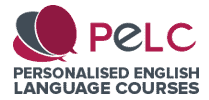English Fluency Course
What are the Main Features of PELC’s English Fluency Course?
- Supplemented by engaging texts based on the author’s life experiences and observations of the world
- Conversation-oriented
- Become familiar with typical phrases and collocations which native speakers use in everyday speech
- Create personalised sentences which contain newly-learned words and collocations
- Benefit from the linguistic analysis and discussion of online news articles. Each article is supplemented by voice recordings and a summary of the most useful words and collocations
How can you improve your spoken English?
Fascinating real-life texts and authentic materials are at the heart of this course.
However, there’s so much more I do for students of this course when it comes to speaking English with confidence and developing learning strategies. As an example of a language learning strategy, I always encourage my students to create true sentences about themselves and their life experiences which contain newly learned words and phrases. It’s not an issue for me to check these sentences. Essentially, having a large stock of personalised sentences significantly contributes to fluency. If you have a system in place to revise these sentences on a regular basis, they will be on the tip of your tongue when you are speaking English.
Spoken competence in English also revolves around removing “clutter” from your mind. It’s easier to “think in English” when you realise that you don’t need to learn the ins and outs of all those grammar points, tenses and aspects you studied to death at school. For instance, you don’t need to worry about the passive voice and uncommon aspects such as the future perfect continuous and future perfect. They’re hardly used in spoken English! Therefore, I get my students to think in terms of 1-2-3-4:
| 1 | Present Simple | Everyday routines / habits |
| 2 | Past Simple | Specific details and completed actions in the past |
| 3 | Present Perfect | Life experiences |
| 4 | Present Perfect Continuous | Past, present and future together |
When it comes to English tenses and aspects, don’t stress yourselves out about the entire spectrum of tenses and aspects. Just have the four aspects mentioned in the table above in your mind.
It’s so much easier to speak English fluently once you begin to get your priorities right. I’ll help you to simplify the English grammar system so you can focus on what really matters when it comes to attaining fluency. For instance, it’s vital to boost your knowledge of collocation. It’s also critical to focus on the way native speakers use connected speech to link words together and create that all important “perception” of fluency.
Can you achieve English fluency in three months?
It’s very difficult to settle on a single definition of ‘fluency’. Does it mean being able to speak at breakneck speed regardless of how many mistakes are made? Does speech sound more fluent when you use connected speech to link words? Is the essence of ‘fluency’ related to striking a balance between accuracy and speed?
Probably, fluency entails a reasonable level of accuracy, and the ability to automatically produce lexical chunks, namely collocations, with ease.
In my view, it’s possible to speak excellent English after six months, provided that you meet certain conditions. For example, it’s vital to have regular contact with English. Several of my students take short classes every second or third day. This means that, on the days they don’t have classes, they still have some contact with English because they have to read an article or listen to a TED talk in preparation for the next class.
It’s also important that you implement and consistently deploy a language learning strategy which you feel comfortable with. I’ve written extensively on this site about the PELC Word-Phrase Table. Essentially, I developed a Word-Phrase Table to help me record all of the new Serbian words and collocations I came across whilst living in Serbia. Not only that, I personalised all of these words and collocations by creating true sentences about myself and my life experiences. My teacher checked my sentences for me. All I had to do was to revise the sentences on a regular basis so that they would be “swimming” in my brain and just ready to be automatically retrieved in the future conversations I had in Serbian.
